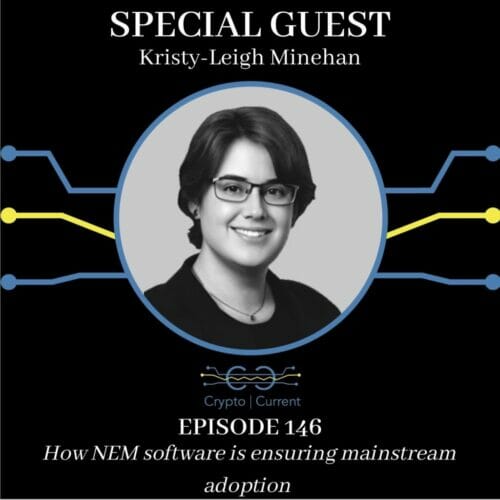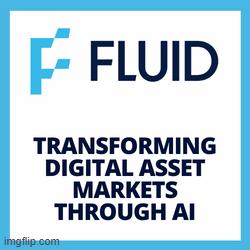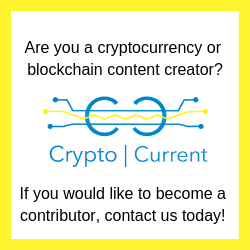Kristy-Leigh Minehan on NEM’s Strategy for Ensuring Mainstream Adoption (Episode 146)
Kristy-Leigh Minehan joins us to discuss how NEM software is ensuring mainstream adoption.
Kristy-Leigh is the Chief Technology Officer at NEM Software. As CTO, Kristy-Leigh is responsible for driving the vision and technical development of NEM’s blockchain solutions.
Regarded as one of the world’s leading authorities on cryptocurrency mining, Kristy-Leigh has spent ten years building up blockchain infrastructure for multiple countries and companies; writing mining and management software; and contributing to the design and implementation of various consensus algorithms. Previously, she was Chief Technology Officer at Core Scientific, where she led out product and technology under CEO Kevin Turner (formerly COO of Microsoft).
Kristy-Leigh is a well known personality in the Bitcoin and Ethereum space, speaking on numerous platforms and podcasts (including HASHR8, PoV Crypto, CoinDesk and more). With an obsessive curiosity and a passion for improving, she continues to teach herself new fields of expertise.
*Disclaimer. None of this information is financial advice.
The following transcript was created using artificial intelligence. There will be some grammatical errors below.
00:00:03:10 – 00:00:12:25
Richard Carthon: Hello, everyone. Welcome to another episode of Crypto Current, your host here, Richard Carthon and today I got a very special guest all the way out in Washington State. We got Kristy with NEM. How are you doing today?
00:00:13:18 – 00:00:21:03
Kristy-Leigh Minehan: I’m doing good, it is a fantastic Sunday. It is not raining for once, which is good, so it’s a pretty good day so far.
00:00:21:21 – 00:00:32:20
Richard Carthon: Awesome. Well, glad you’re getting a nice sunny day and spending some time speaking with us and everyone listening, we’re going to be learning a lot of great things that you have going on. But before we get started, how about you give us a little bit of background on yourself?
00:00:33:21 – 00:01:12:09
Kristy-Leigh Minehan: Sure. So, most people know me by my moniker, Oh God A Girl. I got professionally started in Cryptocurrency mining in 2010 and then Blockchain technology a little bit after that and I focused almost exclusively on the mining side of things for I would say a good six to seven years, specifically optimizing Bitcoin mining and then other kinds of mining. And I wish I had a cool origin story like some of my other heroes, but my origin story was really just fueled by my younger self’s competitive nature. I’ve worked with all sorts of characters in the industry early on when it was still fine to be anonymous.
00:01:12:11 – 00:02:12:21
Kristy-Leigh Minehan: In 2016 I joined Genesis Mining to build and lead out their data center infrastructure in China. And after that, in 2018, I joined Core Scientific as their chief technology officer. Core Scientific’s an interesting character, their claim to fame is they have Kevin Turner, former chief operating officer of Microsoft, as their CEO. Very interesting company, they’re doing some great things. And then in 2020, I joined NEM Software to be their chief technology officer leading out the product in engineering. I also run a consultancy business and technology advisory business focused on broader tech, sometimes Blockchain, sometimes other things. I work with the Roundtable Group as an expert witness in legal cases focused on Blockchain technology, and I also laid out product and engineering in a stealth startup focused on computational imaging technology. So, I’ve got my hands in a lot of cookie jars all at once.
00:02:13:06 – 00:03:15:12
Richard Carthon: Yeah, that is incredible. I mean, jeez, I’m glad you had at least two seconds to take a couple of breaths. That is highly impressive and the fact that you have been in this space for over a decade, you are like one of the OG’s that I’ve been able to bring on the show who has had their hands in a lot of various spots. It’s interesting that the first place you started was in mining. Like the fact that you were one of the first miners, I think just opened your mind to where the opportunity obviously, obviously is in the Crypto, Blockchain space, but then also to be one of the pioneers in building out Blockchain and understanding it and then trying to understand how it can be further developed and brought to this next decade of what I think is going to be seen as user adoption because even now, 10 years later, most people don’t understand what Blockchain is at its core and like how it can be used and everything else like that. Can you kind of just speak to that a little bit of like how you’ve kind of seen it evolve over the years and how you’re even, like, simplifying it for your own team so that you can make sure that you keep building on top of it?
00:03:16:12 – 00:04:12:26
Kristy-Leigh Minehan: Yeah. I think in the you know, in the really early days, there was just Bitcoin. Yes, there were other projects, but Bitcoin was the most notorious and really it was all centered and focused on hardware. There was the money part, but Bitcoin didn’t really have any value with the other coins, didn’t really have any value. So, it was really just focused on how can we build better and cooler hardware to keep acquiring these coins and that almost fuels the competitive nature of the industry. Part of that appeal of mining is that competitive nature of Oshri, you’re trying to aim for a high score and so everyone in the industry has their own method for reaching that high score. And we get all of this innovation around immersion cooling and voltage tweaking and firmware improvements and colonels and algorithmic improvements, all of that can translate into other areas.
00:04:13:06 – 00:05:18:05
Kristy-Leigh Minehan: So, I would say between you know, 2010 and 2014, it was really focused on hardware. And then in 2015, there was almost a shift where we started getting more notoriety and people started getting excited about the potential use cases of what came back and the potential implications of this technology. And you see businesses start to get curious about it and they want their own form of currency or digital tokens or reward system. And then there was that evolution in software and that was really the charge that was led by Ethereum and the potentials that Ethereum showcased around smart contracts and around automation. And what would it be like if we all ran on one giant broad computer and our codes and our program could just execute non-stop? That was a very exciting time. And then in 2018 to 2021, it’s been mostly focused about financial tech, so all of the DeFi saga.
00:05:18:07 – 00:05:18:22
Richard Carthon: Right.
00:05:18:24 – 00:06:00:00
Kristy-Leigh Minehan: And where is that going to be focused on and money. It’s really been focused around CBDCs, FinTech, DeFi. And so, we’ve almost got this normal product evolution of hardware first, software second. Now it’s coming into the usability piece and I think the great challenge we’re going to see in the next five to 10 years is really around design and usability. And design isn’t how something looks, it’s also how all of the parts logically flow together and that’s a big challenge that Blockchain technology still has to address. So, yeah, there’s been a very, very cool evolution to see throughout the course of the space.
00:06:00:02 – 00:06:32:10
Richard Carthon: For sure. And honestly, I really appreciate that like, the timeline of what you’ve seen as the market has kind of matured, you know. And it’s interesting to hear like the focus from hardware over to software, now, the usability like you’re saying. And you know, as we’re kind of like starting this off and you recently just started with NEM Technology, as you said, you’re the CTO. Let’s stay there for a moment, tell us about what you’re doing with NEM and how you’re starting to help with that movement over into more of the usability side of things.
00:06:33:00 – 00:07:13:20
Kristy-Leigh Minehan: Yeah, so NEM Software is a subsidiary of NEM Group and we’re focused almost exclusively on software right now for Blockchain tech. Newly formed as we had mentioned, we’ve got an all star leadership team and one of the best engineering teams I’ve honestly had the pleasure of working with. And specifically we’re focused on right now Symbol, which is our V2 Blockchain protocol. Symbol is this hybrid Blockchain protocol that’s really focused on and targeting enterprise. So, enterprises are now curious about public Blockchain networks, they want to take advantage of some of the capabilities, but they don’t need it all the time.
00:07:14:02 – 00:08:11:18
Kristy-Leigh Minehan: And the specific advantage of a public network is you do get long term data retention, which is nice, you do get really good user engagement and it is a great way to show transparency and a great way to share and corroborate data. But private Blockchain networks provide you a lot of flexibility in fees. Specifically, you know, you can set what you want to pay or you don’t even have to have a cost associated with that, you have a lot more flexibility around your security and your privacy. And so, Symbol was really built to give users the advantage to take advantage of both parts of that, as well as all the additional things that we see businesses now wanting, which is easy tokenization, the ability to reserve human readable addresses, which we call “name spaces,” so that you don’t have to memorize a 64 character string of gibberish as your address.
00:08:12:00 – 00:08:12:15
Richard Carthon: Right.
00:08:12:17 – 00:09:11:26
Kristy-Leigh Minehan: The plug-in system, which is really around being incredibly modular, so you can quickly prototype a new feature or build a new feature and have that as a plug-in into the Symbol Blockchain. It’s pluggable, so really the future roadmap has been built around enterprise first. And we also have NIS1, which is what we’re most famous for. NIS1 being the first Blockchain protocol that was started in 2013, launched in 2015. It’s the top ten Cryptocurrency now and NIS1, for whatever reason, is viral in Japan. It’s taken off in Japan, so, we have a lot of support and a large following in Japan and a lot of cool projects have been built on that, including one of the world’s first digital collectible coins made with the Bank of Lithuania. So, LBCOIN and as well as the first tokenized whisky fund.
00:09:12:03 – 00:09:50:18
Kristy-Leigh Minehan: I had no idea that whiskey was a form of investment, but my eyes have been opened. And so, the way Financial Group and NEM came together to allow investors to easily invest in whiskey and they get their own little token that represents their whiskey, that barrel and access a certificate of authenticity. So, pretty cool projects on the horizon there. And yeah, I’m really focused on what comes next. You know, we’ll have our launch, but there is an entire future to not only Symbol, but future product lines, some things that we can’t talk about today, some things we can.
00:09:50:27 – 00:10:31:08
Kristy-Leigh Minehan: And most of what I’m focused on is ensuring that the Blockchain protocol does meet the needs of all of our consumers. A lot of privacy, specifically around zero knowledge proofs and how do you ensure privacy in the data you transact, but making sure it’s all compliant with, you know, regulations. And I think the third big thing is just design, making sure that it is usable and accessible for people that are not you know, they’re not CTOs, they’re not engineers. For Blockchain to really make sense, it has to be usable by all of your business folks, by all of your sales folks, by anyone within the company.
00:10:31:25 – 00:11:08:06
Richard Carthon: Absolutely. And you know, thank you for giving us a breakdown of all that, that’s all exciting. And we’re definitely going to have to talk offline just on the whiskey one, because I personally love whiskey and have a lot of aspirations for things I want to do with that in the future. But one of the things that kind of clicked for me with everything you just said and what I will always go back to for everyone that’s listening is that Blockchain opens the doors to so many other opportunities you would have never even known existed until someone like puts the thought in your head like, Oh, wow, this is a way that I could run a business, Blockchain could help me bridge that gap and now I could build this whole enterprise on top of it.
00:11:08:14 – 00:11:44:26
Richard Carthon: And it’s just finding the means of having the visibility or the vision to like try to create some sort of business model, then you do the connection of, All right, well, here’s how we can connect this with Blockchain and here’s how we can now set up this whole business operations basically from start to finish, from technology to business model to usability for the end user or end consumer, like I think that’s beautiful. And I always go back to building for the future, like this next decade, amazing, an immense amount of opportunity in specifically the Blockchain space.
00:11:45:01 – 00:12:14:17
Richard Carthon: And for the innovators, the people who have the vision of like, Okay, you know, for example, you just brought up the whiskey fund, but you know, the same way that people do that with whiskey, they probably also do it with wine, with other things as well. You can probably spin up something like that for a ton of other things. So for people listening, you might have something that just clicked in your head like, Wow, I bet I could do that for X, how can I now set that up? And NEM would be a way that you’d potentially be able to do that. And I just want to spend a moment to like, re-emphasize like, how awesome that is that Blockchain like gives those kinds of opportunities.
00:12:15:07 – 00:12:57:20
Kristy-Leigh Minehan: And that’s really what I want to focus on for the next you know, two to three years. How do we make it so that if you have an idea, you can click a few buttons and boom, your idea is brought to life? And I think that is the next gap that we’re missing in the evolution of Blockchain tech. We kind of had this evolution happen within operating systems where before it was very much a command line terminal base and then all of a sudden you had the graphical user interface. Yes, I know the purist in me is saying, Ah that, but you know, it was really important for the home user to understand and have something that they could visually work with to be able to interpret a lot of the complex stuff that’s happening in the background.
00:12:58:05 – 00:13:46:26
Kristy-Leigh Minehan: And it’s that very small thing about design that really does push technology into the hands of mainstream and that is what we’re trying to focus on. How can you bring that same sort of usability and ease of use that Apple is renowned for, that Microsoft is, that all of the big giants are, bring that to Blockchain tech and so that you can quickly prototype an idea or click a button and it’s launched and when you’re ready, yes, you can dive in and make more much more complex optimizations. I think that is you know, the next step. It’s great to be a store of value and it’s great that Cryptocurrencies are out there, but there’s another layer to Blockchain tech that needs to be addressed. So, pretty excited to spend some time working and focusing on that.
00:13:46:28 – 00:14:36:02
Richard Carthon: I just want to spend a little bit more time here because I think we need to continue to stress how important usability is and simplicity. Now, I’m sure through the course of your experience with working now, I mean, not just in Crypto, but just in your professional career, like, when did you see that switch of like, Oh, I have this great idea, let me go build this thing, but then realizing it needs to be useful, it needs to be so simple that anyone can pick it up and use it? Because I always go back to people who create really great projects and concepts and they’re like, Oh my gosh, this is great, anybody could use it, but they don’t think about from the standpoint from the beginning how the end user is going to use it, how are they going to experience it, how are they going to use and move this forward. What experiences did you go through to make that like, we need to focus on this first?
00:14:36:22 – 00:15:37:08
Kristy-Leigh Minehan: I mean, I think we’ve seen it all throughout Blockchain tech specifically. So if I focus on that, the evolution of a node, you know, before there was what I would call the “purist era,” which said we’ll have dedicated nodes that also mine that are also wallets and they’ll always be connected and they’re going to be these big bulky machines. And then slowly it evolved to the point where you know, there’s no value in running a node for many people and so they’re just not run. But on top of that, they’re often complex to set up. You know, you have to get the software right, you have to compile it yourself, until a company called Casa came along and made this fantastic just ready to plug in Bitcoin node, was a fantastic piece. All of a sudden, people are starting to run Bitcoin nodes because they don’t have to do that setup, they literally just use their phone, click a few buttons and they plug it into power. It was the same in the mining industry.
00:15:37:19 – 00:16:53:09
Kristy-Leigh Minehan: Before Bitmain had really pioneered the plug-and-play machines, a lot of the A6 devices required some DIY. So, really like early on 2011, 2012, you could just buy A6 chips and you can make your own A6s from your own breadboard and build your own PCPs. And that was because well number One, the industry was a lot smaller, it was a lot close knit. But Two, we weren’t really focused on that usability piece until mining became a little bit more mainstream and people said this is incredibly inefficient. Bitmain came out with this what we call the “shoe box design,” which essentially just looks like a giant rectangle with different blades in it, hashboards that you can pull out and replace. That’s become the industry standard and that was usable from, I would say, the operations side of things and then when it came to the rest of mining, you know, setting up a mining farm, making sure that you’re connected to a mining pool, that wasn’t really addressed until 2019. And then we started to see that evolution even in wallets.
00:16:54:05 – 00:18:08:02
Kristy-Leigh Minehan: Back in the day, you would have to run your own Bitcoin node and that would be your wallet, until we had light nodes, which were disconnected from that to eventually mobile wallets, which are far more accessible and hardware wallets, where if you need that extra layer of security. You have a hardware wallet and then you can chuck it in your safe. So, we’ve started to see this trend, but it’s all been centered around other aspects of the industry, you know, mining or the actual Cryptocurrency itself, the storage and usage of it. No one’s really going and said, “Okay, let’s go and make some visual interface around building a dam or a visual interface around building a smartphone track.” And then Blockchain protocols all on their own, you know, if you really want to get optimisations Ethereum, you have to really study the EVM and know how to do op-code optimizations, which are out of reach for someone who’s just starting. So, imagine if you had a piece of software that handled a majority of that for you in the same way that compilers today in you know, in technology make a lot of decisions for us. Yes, they’re bad some of the time, but you know, 90 percent of the time compilers do their job right.
00:18:08:09 – 00:18:08:24
Richard Carthon: Yeah.
00:18:08:26 – 00:18:37:16
Kristy-Leigh Minehan: And some OpenGL people and Linux folks are going to kill me for that comment, but at least in my landscape, compilers are pretty, pretty decent now. So yeah, I think there’s just that evolution that’s happening and there’s that last point that we need to reach on now addressing the needs of the rest of the world on here’s how you can go and create your own dApp, here’s how you can go and create your own little Blockchain, Blockchain concept. Click a button and have it launched.
00:18:37:18 – 00:19:12:18
Richard Carthon: I agree. I’ve referred to it on previous episodes as “completing the circle of where we are.” And that last, like I want to call it, anywhere from 20 to 10 percent is the closing of the loop of Okay, here are all these great things, but now how does anybody pick this up and build it? And like now I can build this company that is self sustainable, that uses all of the different elements of the Crypto, Blockchain space, and it’s fun to see that we’re closer than we were a few years ago. And I think there’s nothing but gas being put on this fire because of COVID.
00:19:12:26 – 00:19:48:08
Richard Carthon: And as the world looks into a more remote culture and being decentralized and a lot of different facets of reality, whether it be from how you vote or how you make payments or how governments are sending out stimulus or anything like that, like there’s a lot of use cases for Blockchain. And now because we are in such a decentralized world, people are paying a lot more attention and saying like, “Oh, well, I know you told me about this thing a couple of years ago, I’m listening now, let’s go.” And that’s been pretty cool to see as well.
00:19:48:26 – 00:20:19:28
Kristy-Leigh Minehan: And part of the appeal of Blockchain tech, it’s most people really focus on the data retention and the data transparency, no one really focuses on the implications of the automation part of it. If you can have something run 24/7, no downtime in theory and it will just be perpetual, that is insanely powerful. One of the projects I previously worked on was, this will be a little out there, but making military drones buying Bitcoin.
00:20:20:11 – 00:20:20:26
Richard Carthon: Wow.
00:20:20:28 – 00:21:12:18
Kristy-Leigh Minehan: Yeah, I know. But one of the really cool pieces of that is we had to engineer a way where we could have code stored and accessible to these drones for deployment, irregardless of the company’s lifetime, meaning if my former company, if they shut down you know, and we were all laid off, the code was still somewhere and not controlled by us and if the drone company shut down, the drones could still get regular deployments or updates. That was actually solved through smart contracts and making sure the entire report was available through Blockchain tech. And it would continue to exist as long as there were two drones deployed somewhere out there. And so, I think that’s a powerful untapped potential of Blockchain.
00:21:13:07 – 00:22:03:11
Kristy-Leigh Minehan: Think about all of the things that could be automated and don’t need people. Payroll systems are a great example. Why the hell do we still need payroll systems that require you to manually submit payroll? Why can that not just be fully automated? Why can it not be recorded and just executed and be automated on chain? There is no reason it can’t. And I think you know, the constant theme of removing humans from the equation and just automating things scares a lot of people, but that is the way the industry is trending as well, not just in Blockchain tech, but in artificial intelligence and robotics, in manufacturing. It’s trending in that direction, Blockchain can really help realize that potential.
00:22:03:13 – 00:22:31:02
Richard Carthon: For sure. And everyone listening, go listen to that again, because that is mind blowing. My mind’s blown. I’m going to go back and listen to it a couple of times. The fact that we’re getting to a place where really after a concept or a thing is put in place, it just works. You don’t have to go back and update it utilizing smart contracts and just having that go and function. Like what blows my mind about is that you were able to identify it with something like a drone. You could go and apply this to anything.
00:22:31:07 – 00:23:10:05
Richard Carthon: Even when you’re talking about payroll, the fact that, you’re right, like if people are performing the work, it should just automatically hit. And I mean, yeah, you can put some protocols in place that in case something doesn’t happen that you can, like, turn it off. But all the same things should be automatic and reoccurring and the operational efficiency of things will continue to increase. And like that is super exciting. And again, my mind is turning with all the various things that could happen with it. But, as we look into this next decade, as we are starting to look at the current horizon, what are things that you are looking out for that you think others should be looking out for as well?
00:23:10:28 – 00:23:39:21
Kristy-Leigh Minehan: In particular, I’m really focused on decentralized storage and decentralized CDMs. And the Sia project, so they have a cryptocurrency called Siacoin, they have their own form of Dropbox called Skynet. I’ve been paying close attention to them because they’ve managed to get to figure out how to do video streaming over Blockchain networks, which is fantastic.
00:23:40:02 – 00:23:40:17
Richard Carthon: Wow.
00:23:40:19 – 00:24:37:13
Kristy-Leigh Minehan: And I think that is powerful. You know, censorship resistant video could absolutely change the world for media and journalists. And yes, it has bad implications as well, but a good friend of mine taught me that bad guys will always find a way to use technology, you can’t let that stifle innovation. So, I’m paying a lot of close attention to them, to Storage, a bit to Peercoin as well, who focuses on video live streaming, but coming at it from a different angle, using mining GPUs to encode videos on the fly in proof-of-work networks, so that’s pretty cool. Paying close attention to MobileCoin. MobileCoin is interesting because Moxie, the founder and developer of Signal, the messaging app.
00:24:37:23 – 00:24:38:08
Richard Carthon: Right.
00:24:38:10 – 00:25:49:01
Kristy-Leigh Minehan: Is one of their advisors and they’re focused almost exclusively on privacy, but also being this lightweight payment system. So, I’ve been paying attention to them. Handshake, you know, I’m a big fan of what they’ve done with intranet domains. And then of course, Ren with Ren Protocol. All of these kinds of tokenized assets and of course, the ever evolving DeFi drama. I have to say, Yams and Sushi got me through COVID, it was a fun time. Someone on Twitter said it best, “We’re now going into the next phase of Ethereum, where it’s now finance is a video game.” People are treating you know, this as money’s a video game. And I know that can be kind of scary for your traditional CFA and your traditional hedge funds, but it is an exciting time to be in and it’s teaching a whole new generation of people about all of these complex economical concepts in a fun, easy, silly manner that the Internet is known for.
00:25:50:00 – 00:26:53:15
Kristy-Leigh Minehan: So, I think those big trends are something to pay attention to. And then there’s also this larger trend that’s happening where we are seeing really big hardware companies, semiconductor giants and financial institutions building out Cryptocurrency mining farms, which is new and exciting because that really means that we’ve hit mainstream adoption. Galaxy Digital just launched their mining fund. There are a few other financial firms and financial institutions that are starting to deploy Bitcoin miners just so they have a ready stream and access to these coins that they can then give to interested investors. And so, I think that is quite interesting. I think that has proven that Bitcoin as a technology has become an alternative form of volume storage. Some interesting trends to pay attention to.
00:26:54:03 – 00:27:44:24
Richard Carthon: Definitely. You have given a lot. So many great things that you brought up. Again, talking about the DeFi space and what’s coming with that. I like how you said Ethereum was almost like playing a video game, like I think that’s going to resonate with a lot of people because you’re right, like how do you gamify the financial world? And like as it kind of connects more dots for basically the next generation from millennials to Gen Zers and everyone else and just seeing like where traditional finance is kind of really taking a hard left and you’re starting to see Fintech, Blockchain, Crypto, everything else kind of become more center stage and where everything is moving towards. If this generation can kind of learn that, they’re going to be set up from the beginning to just be so much further ahead than everyone else.
00:27:45:15 – 00:28:31:27
Richard Carthon: I continue to call Crypto “the great equalizer” just because, again, it is extremely early still, if you can learn all the various ways that you can get in, there’s just limitless potential of access and opportunity that like you don’t need a ton of money to get into. You can just put a little bit and it could literally change your life. Like it’s an exciting time and everyone listening again today, you don’t necessarily have to go and spend a ton of money to get into this, but like, just find something that you’re passionate about or that makes sense and just get involved. You put $5, you can put $10, whatever it is, just find a way to figure out what that project is, figure out how you can somehow get it and just start. And like from that first step, the rabbit hole begins and like you really start to get involved in this amazing space.
00:28:32:22 – 00:29:16:01
Kristy-Leigh Minehan: Or even just buy you know, $10 worth of a few projects, throw it into a wallet and then don’t look at it for five years. And I mean, that is honestly, if you look at all of the people that got started early on, there were a few of us yes that were consistently in the industry, but you also have a handful of people that bought or sold Bitcoin, you know, they were only in the space for like two days and then it was just stored. And now 10 years later, all of a sudden they’re multimillionaires. It’s the same for stocks. It’s the same advice they give you to new companies and why you should invest.
00:29:17:24 – 00:30:29:10
Kristy-Leigh Minehan: I think that it’s easy to get started. I think sometimes it’s very daunting for people because they’re always, you know, comparing the money that they would have now versus the money they’ll have in 10 years and I do get that. You also touched on a very interesting point of it is the great equalizer. It turned a bunch of people that a bunch of 17 to 20, 23 year olds into millionaires overnight, just through one big week of a great Bitcoin rally and that is an interesting evolution in our financial systems. And all of a sudden you have people that are younger than me or my age now taking senior roles at funds and in the technology industry. And they’re competing on that level and it’s not because you know, they have to, it’s because they believed in this technology. And some might say they got lucky, but now they’re able to contribute their ideas and evolve the world in a way they see fit. That’s an exciting time.
00:30:29:23 – 00:30:57:28
Richard Carthon: That’s so exciting. And like, I just want to stay there for a second, which is so cool that you bring up, like, the fact that these people, first they got access. So first of all, anyone that’s listening to this podcast and to our show, you already know we’re giving you access early, we’re giving you the means to at least know it exists, it’s on you to act and to do something with it. But from there, the fact that these people took the action, it changed their lives in such a way that now they can go to these larger corporations and they have a voice at the table. It’s giving you access, it’s giving you a seat at the table.
00:30:58:03 – 00:31:42:04
Richard Carthon: I mean, how many people that you know, you’re in your space and you have, like local family, who knows nothing about it and all of a sudden they’re hitting you up now. Now that it’s a bull market now that people are finding out about Crypto and Blockchain. You’ve been talking about it once or twice, they’re like, Hey, hey, remember you told me about this thing? Tell me more about it. One more quick antidote, I had a friend who bought like five Bitcoin, I think like five or six years ago, forgot about it and then they forgot their password and they hit me up literally two days ago, and they said, “You won’t believe this, I got the password Rich.” And I was like, that’s so awesome. But anyway, you know, this has been an amazing conversation. You’ve given us so much just knowledge and just things to ponder and think about. But, you know, Kristy, what is a final thought that you want to leave with all of our listeners here today?
00:31:43:19 – 00:32:30:15
Kristy-Leigh Minehan: I have many thoughts, but let’s see. I think we already touched on it, just go buy some coin, Bitcoin Ethereum. Please, please buy some Symbol, buy NEM, but just get started in Cryptocurrency. Don’t wait any longer, don’t wait until the price drops. Don’t keep doing that to yourself, just buy some and just hold it. It does, it really does change your life. Start looking at this technology, start looking at its other implications, start looking at how it’s being used. We are now at the great cusp of the tech where it’s had its rough patches and it’s starting to see mainstream adoption.
00:32:30:25 – 00:33:17:28
Kristy-Leigh Minehan: The big feedback I get from a lot of people saying it’s too late, it’s too late for me to get started, you know, the bull run’s already happened or it’s already gone mainstream. It’s not too late, it is never too late. Nothing is stopping you, literally it’s all at your fingertips now. If you want to get started, you can open a Robinhood account and invest, you can grab a Coinbase wallet if you’re in the U.S. and link your bank account. It’s very easy. Or if you fancy mining, just go and download a miner and start playing around and tinkering at home. It’s one of the great things of proof-of-work networks, they’re accessible. So, just get started, don’t wait.
00:33:18:11 – 00:33:27:24
Richard Carthon: Yes, I love that final thought. I’m not going to add anything to that, I think that was perfect. But Kristy, thank you so much. What are ways that people can connect with you and also learn more about NEM?
00:33:28:24 – 00:34:03:26
Kristy-Leigh Minehan: Please follow me on my official Twitter. So, that is @OhGodAGirl. Mostly I just tweet about the industry, but sometimes there’ll be one or two insightful, witty things on there. And then also to find more about NEM, you can visit our website at N-E-M.io. We put all of our latest updates there. I do encourage people to start getting a simple node up and running for our launch in February, it will be a very exciting time.
00:34:04:23 – 00:34:09:20
Richard Carthon: Awesome. Well, again, thank you so much for spending some time with us and for everyone listening, stay Crypto Current.
Crypto Current will be guiding all of you who are new to the cryptocurrency world to becoming a cryptocurrency and blockchain expert. Crypto Current was founded to give access to information to everyone on current events occurring in cryptocurrency and blockchain in a digestible way. Since its creation, we have created content that impacted thousands of people through its podcast, blog, and social media.










